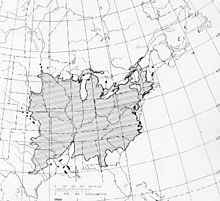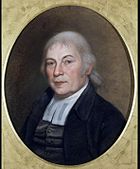- Ulmus rubra
-
Ulmus rubra 
Mature cultivated Slippery Elm (Ulmus rubra) Scientific classification Kingdom: Plantae (unranked): Angiosperms (unranked): Eudicots (unranked): Rosids Order: Rosales Family: Ulmaceae Genus: Ulmus Species: U. rubra Binomial name Ulmus rubra
Muhl.[1]
The native range of slippery elm. Synonyms - Ulmus americana L. var. rubra Aiton
- Ulmus crispa Willd.
- Ulmus dimidiata Raf.
- Ulmus fulva Michx., Loudon, Bentley & Trimen, Sarg.
- Ulmus pinguis Raf.
- Ulmus pubescens Walter?, Sudworth, Pinchot
Ulmus rubra, the Slippery Elm, is a species of elm native to eastern North America (from southeast North Dakota, east to Maine and southern Quebec, south to northernmost Florida, and west to eastern Texas). Other common names include Red Elm, Gray Elm, Soft Elm, Moose Elm, and Indian Elm.
Contents
Classification
 Gotthilf Heinrich Ernst Muhlenberg, who named Ulmus rubra in 1793. Portrait by Peale, 1810.
Gotthilf Heinrich Ernst Muhlenberg, who named Ulmus rubra in 1793. Portrait by Peale, 1810.
This widespread, common North American forest tree species was named several times, with Pennsylvania botanist Gotthilf Heinrich Ernst Muhlenberg's 1793 name Ulmus rubra now accepted as the first formally published. The slightly later name U. fulva, published by French botanist André Michaux in 1803, is used in much of the older literature, and is still widely used in dietary-supplement and alternative-medicine information.
The slippery elm has almost universally been treated taxonomically as a distinct species without named subspecies or varieties. However, it was sometimes considered a variety of the American Elm, Ulmus americana var. rubra, in the late 18th century. The species is similar to American Elm (U. americana) in general appearance, but more closely related to the European Wych Elm (U. glabra), which has a very similar flower structure.
Description
Ulmus rubra, the Slippery Elm, is a deciduous tree which can grow to 65 feet (20 m) in height with a 20-inch (50 cm) d.b.h. trunk. The tree's more upright branching pattern differs from the deliquescent branching of the American elm. Its heartwood is reddish-brown, giving the tree its alternative common name 'Red Elm'. The leaves are 4-6 in (10–18 cm) long and have a rough texture (especially above), coarsely double-serrate margins, acuminate apices and oblique bases. The perfect, apetalous, wind-pollinated flowers are produced before the leaves in early spring, usually in clusters of 10–20. The fruit is an oval winged samara about 3/4 in (20 mm) long that containing a single, central seed. Slippery elm may be distinguished from American elm by the hairiness of its buds and twigs (both smooth on the American elm) and by its very short-stalked flowers.
Pests and diseases
The tree is reputedly less susceptible to Dutch elm disease than other species of American elms,[2] but is severely damaged by the Elm Leaf Beetle (Xanthogaleruca luteola).[3]
Ecology
Slippery Elm thrives in moisture-rich uplands, but it will also grow in dry, intermediate soils.[4] In the central United States, native Ulmus rubra hybridizes in the wild with the Siberian elm (U. pumila).[5]
Cultivation
The species has been introduced to Europe and Australasia.
Hybrid cultivars
U. rubra had limited success as a hybrid parent in the 1960s, resulting in the cultivars 'Coolshade', 'Lincoln', 'Rosehill', and probably 'Willis'.[6] In later years, it was also used in the Wisconsin program to produce 'Repura' and 'Revera' [7] although neither is known to have been released to commerce.
Etymology
The epithet rubra (red) alludes to the tree's reddish wood, whilst the common name "Slippery Elm" alludes to the mucilagenous inner bark.
Accessions
- North America
- Arnold Arboretum. Acc. nos. 737-88, 738-88, both of unrecorded provenance.
- Bernheim Arboretum and Research Forest [3], Clermont, Kentucky. No details available.
- Brenton Arboretum, Dallas Center, Iowa. No details available.
- Chicago Botanic Garden, Glencoe, Illinois. 1 tree, no other details available.
- Dominion Arboretum, Ottawa, Canada. No acc. details available.
- Longwood Gardens. Acc. no. L-3002, of unrecorded provenance.
- Nebraska Statewide Arboretum. No details available.
- Smith College. Acc. no. 8119PA.
- U S National Arboretum [4], Washington, D.C., USA. Acc. no. 77501.
- Europe
- Brighton & Hove City Council, NCCPG elm collection [5]. UK champion: Hove Recreation Ground, 18 m high, 65 cm d.b.h. in 2002.[8]
- Grange Farm Arboretum, Sutton St James, Spalding, Lincolnshire, UK. Acc. no. 522
- Hortus Botanicus Nationalis, Salaspils, Latvia. Acc. nos. 18168, 18169, 18170.
- Linnaean Gardens of Uppsala, Sweden. As U. fulva. Acc. no. 1955-1052.
- Royal Botanic Garden Wakehurst Place. Acc. no. 1973-21050.
- Thenford House arboretum, Northamptonshire, UK. No details available.
- University of Copenhagen Botanic Garden. No details available.
- Australasia
- Eastwoodhill Arboretum [6], Gisborne, New Zealand. 1 tree, no details available.
Nurseries
North America
Europe
- Arboretum Waasland [8], Nieuwkerken-Waas, Belgium.
- Arne Herbs Arne Herbs, UK, UK
- Grange Farm Plants, Spalding, Lincs., UK.
- Salley Gardens Salley Gardens, UK, UK
Seed suppliers
- B and T World Seeds, Paguignan, 34210 Aigues-Vives, France
- Sheffield's Seeds Co. Inc. [9], New York, USA.
Uses
Medicinal
Slippery elm (Ulmus rubra) has had various traditional medicinal uses.
The mucilagenous inner bark of the slippery elm has long been used as a demulcent, and is still produced commercially for this purpose in the United States with approval for sale as a nutritional supplement by the U.S. Food and Drug Administration.[9]A tea brewed from the inner bark helps ease a sore throat and irritated stomach – in addition to other mucous membranes. Sometimes slippery elm leaves are dried and ground into a powder, then made into a tea. Both slippery elm gruel and tea are said to soothe the digestive tract.[10]
Whole bark of slippery elm was used as an abortifacient,[citation needed] but not without serious consequences, such as death of the mother.[citation needed]
Other uses
The wood of the slippery elm is used for the hubs of wagon wheels, as it is very shock resistant owing to the interlocking grain.[11]
The tree's fibrous inner bark produces a strong and durable fiber that can be spun into thread, twine, or rope[11] useful for bow strings, ropes, jewellery, clothing, snowshoe bindings, woven mats, and even some musical instruments.[citation needed]
Once cured, the wood is also excellent for starting fires with the bow-drill method, as it grinds into a very fine flammable powder under friction.[citation needed]
References
- ^ "Ulmus rubra information from NPGS/GRIN". www.ars-grin.gov. http://www.ars-grin.gov/cgi-bin/npgs/html/taxon.pl?40855. Retrieved 2008-03-14.
- ^ [1]
- ^ [2]
- ^ Ulmus rubra Muhl
- ^ www.onlinelibrary.wiley.com
- ^ Green, P S (24 July 1964). "Registration of cultivar names in Ulmus" (PDF). Arnoldia 24 (6–8): 41–46. http://arnoldia.arboretum.harvard.edu/pdf/articles/1605.pdf.
- ^ Santamour, Frank S; Susan E Bentz (May 1995). "Updated checklist of elm (Ulmus) cultivars for use in North America". Journal of Arboriculture 21 (3): 122–131.
- ^ Johnson, Owen (ed.) (2003). Champion Trees of Britain & Ireland. Whittet Press, ISBN 978-1-873580-61-5
- ^ Braun, Lesley; Cohen, Marc (2006). Herbs and Natural Supplements: An Evidence-Based Guide (2nd ed.). Churchill Livingstone. p. 586. ISBN 9780729537964., quote:"Although Slippery Elm has not been scientifically investigated, the FDA has approved it as a safe demulcent substance."
- ^ "Bile reflux: Alternative medicine - MayoClinic.com". www.mayoclinic.com. http://www.mayoclinic.com/health/bile-reflux/DS00651/DSECTION=alternative%2Dmedicine. Retrieved 2010-02-03.
- ^ a b Werthner, William B. (1935). Some American Trees: An intimate study of native Ohio trees. New York: The Macmillan Company. pp. xviii + 398.
External links
Categories:- Ulmaceae
- Trees of the United States
- Trees of Alabama
- Trees of Canada
- Medicinal plants
- Demulcents
- Trees of Ontario
Wikimedia Foundation. 2010.


